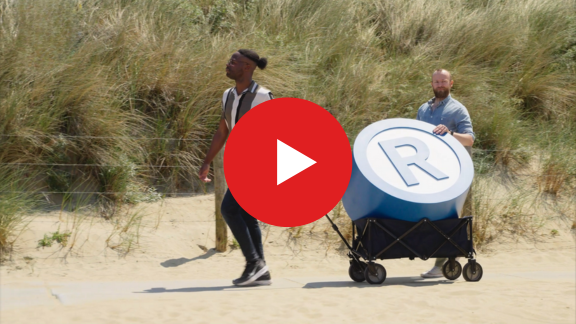Every country – or sometimes even every region – has a different business climate, as well as its own laws and regulations. That is also true for trademark rights. If you have registered your trademark in the Benelux and want to do business internationally, it is wise to invest in smart trademark strategy.
- There is actually no such thing as ‘worldwide trademark protection’. You have to arrange your trademark protection in the countries or regions where you are active and where you want protection.
- Expanding abroad is a serious move. It is advisable to engage the services of a legal expert in intellectual property (IP).
- There are three different ways for you to expand your trademark registration. Which is the most suitable depends on your circumstances.
- If you have not yet registered your trademark but do have ambitions to do business internationally, you can also read: How to form a sound basis for your international trademark protection.

Option 1: an EU trademark - If you intend to restrict your business to within the EU, then an EU trademark is a good option.
For example, perhaps you are active in the Benelux and want to expand your business to Spain, Portugal and France. If so, an EU trademark is then an interesting option.
Applications for EU trademarks via EUIPO
You can apply for an EU trademark via EUIPO (European Union Intellectual Property Office). With an EU trademark your trademark is registered for all 27 countries of the European Union at once. Fee for an EU trademark: from €850 for 10 years.
The advantage of an EU trademark is that, proportionally, it is much more cost-effective than applying to register a trademark for each EU country individually.
The disadvantage of an EU trademark is that there are more risk factors involved. For example, if your application is not distinctive in just one of the EU countries, it will be refused overall for all the EU countries together. The ‘all or nothing’ principle is applied. That is also true if one party in just one country files an opposition against your trademark and that opposition is upheld. We explain how it works below.
‘All or nothing’ principle explained
Example: You have a Benelux trademark. You are now also considering doing business in Spain, Portugal and France. An EU trademark can be an interesting option in this case. The advantage is namely that you only have to apply once via EUIPO and you only pay one fee. There is a risk though that your entire application will be void should your trademark be refused because, for instance, in one of the 27 EU countries, it appears not to be distinctive – even if you are not looking to do business in that particular country. The same is true if a successful opposition is filed against your trademark in one of the 27 EU countries. Moreover, in such cases you also lose your application fee.
How to navigate the ‘all or nothing’ principle wisely
The good news is there is a smart way to navigate this ‘all or nothing’ principle, and that is by incorporating your EU trademark in a so-called international trademark registration (the WIPO route). You can find out how that works by reading Option 2 > EU trademark via WIPO.
Expanding abroad is a serious move. It is advisable to engage the services of a legal expert in intellectual property (IP). Find an IP professional through the Benelux Association for Trademark and Design Law.
Option 2: The WIPO route – File a single trademark application for the EU and beyond, in countries that you choose.
Via WIPO, the World Intellectual Property Organisation, you can apply to register your trademark for several countries at the same time in one go. You can choose from more than 120 countries that are Contracting Parties to the Madrid System, which is an international treaty simplifying the process for obtaining registered trademarks in several countries at the same time. Which countries you choose is up to you, and you pay per country. You can see it as a 'bundle of rights’ you apply for with a single application.
To register your trademark internationally through this route you must always already own a ‘basic trademark’, such as a Benelux trademark or an EU trademark.
Calculate your fee using the special WIPO calculator.
Applications for EU trademarks via WIPO
It is also possible to apply for an EU trademark via WIPO. This will help you better anticipate the ‘all or nothing’ principle of an EU trademark. The advantage is that, should your EU trademark be refused, you can turn this application into separate national applications, both relatively easily and cost-effectively. You do have to own a basic trademark to start with though (a Benelux trademark, for example).
For example, say you apply via the WIPO route for an EU trademark, and it then appears that your trademark is not distinctive in, for instance, Spain. Your EU trademark will be refused as a result. The ‘all or nothing’ principle still applies. However, because you filed your application through WIPO, you can decide to turn your application into separate applications for each EU country individually. You might, for instance, want to apply only to non-Spanish-speaking countries. Together then, those separate applications constitute your ‘bundle of rights’. It means your application was not filed in vain.
Option 3: Apply to register your trademark per country – because not all countries are Contracting Parties to the Madrid System.
Do you want to expand your Benelux trademark registration to several countries in the EU and beyond, at the same time? If so, along with the EU trademark and the WIPO route, you also have the following option: you can apply for individual trademark registrations in the countries themselves. For instance, you might want to apply to countries that are not Contracting Parties to the Madrid System. You can do this through the national trademark offices of those countries. Fees vary per country.
What the best option is for you depends on your circumstances
What the best option is under your specific circumstances depends on several factors. These can be, for example:
- the budget you have available;
- the distinctive character of the trademark in the countries chosen;
- the availability of the trademark in the countries chosen;
- the risks that you are prepared to take.
Is trademark registration useful for your business?
You only actually own your name or logo if you have registered your trademark. If you have, then you have a monopoly on your brand. There are many advantages to that. Read all about it on our page ‘All about trademarks’.



